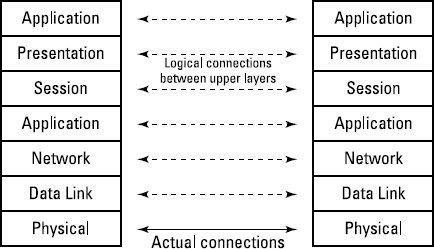Using Layered Architecture
Layered architectures have been around since the beginning of digital computers — or at least since the early 1960s. Modern hardware technology and languages accentuate the usefulness of layered architectures, as you see in the three examples in this section. All three of these examples are in use all around you right now, in the systems you use every day.
Keeping communications open
The International Standards Organization (ISO) Open Systems Interconnection (OSI) seven-layer model (see Figure 9-1) facilitates communication between computers. The model consists of two separate but parallel stacks of layers; each layer provides a higher level of functionality than the layer below it. Within the two stacks, the layer N in one stack is a peer of the layer N in the other stack. Logically, communication is between the peer layers in the two stacks; actually, only the bottommost layer directly communicates between the two stacks.

Figure 9-1: The OSI seven-layer model.
Layers can be different sizes, hosting different numbers of protocols. Over time, in fact, the communications-stack diagram has evolved into many variations. Some layers have many alternatives — such as SIP, FTP, Telnet, and HTTP in layer 7 (the Application layer) — and other layers have few alternatives.
Something that's true of layered architectures in general is true of the OSI model as well: ...
Get Pattern-Oriented Software Architecture For Dummies now with the O’Reilly learning platform.
O’Reilly members experience books, live events, courses curated by job role, and more from O’Reilly and nearly 200 top publishers.

